As someone who manages multiple commercial properties, I’ve learned that selecting the right outdoor trash can is not just a practical decision; it significantly affects hygiene, safety, and the perception of your business. Poorly chosen bins can result in overflowing waste, pests, unpleasant odors, and even regulatory issues. Over the years, I’ve refined my approach to choosing and maintaining commercial outdoor bins to ensure efficiency, cleanliness, and durability.
In this guide, I’ll walk you through:
- The types of commercial outdoor trash cans.
- Detailed usage scenarios for each type.
- How to maintain your bins for longevity.
- Common mistakes businesses often make.
- Tips and FAQs to make your decision easier.
In This Guide, I’ll Cover
ToggleWhy Commercial Outdoor Trash Cans Matter
I’ve witnessed firsthand the impact of well-placed and properly chosen trash cans. They don’t just keep your property clean, they enhance customer satisfaction, ensure compliance with health codes, and reduce pest problems. The wrong bin can quickly turn a neat outdoor area into a messy and unhygienic space, reflecting poorly on your business. To choose the right bin, you can checkout How I Choose the Best Outdoor Garbage Can for Any Space.
Key Features I Always Look for in Commercial Bins
Before selecting a bin, I always assess:
- Durability: Industrial-strength plastics or metals that withstand weather, frequent use, and occasional vandalism.
- Capacity: Bins should match your traffic volume: 30 gallons for walkways, 100+ gallons for high-traffic areas.
- Ease of Use: Open-top, swing-lid, or foot-pedal designs depending on who will use the bin.
- Weather Resistance: UV-resistant plastics and rust-proof metals.
- Pest Prevention: Lockable lids or animal-proof designs in areas prone to wildlife.
Types of Commercial Outdoor Trash Cans
1. Plastic Resin Trash Cans
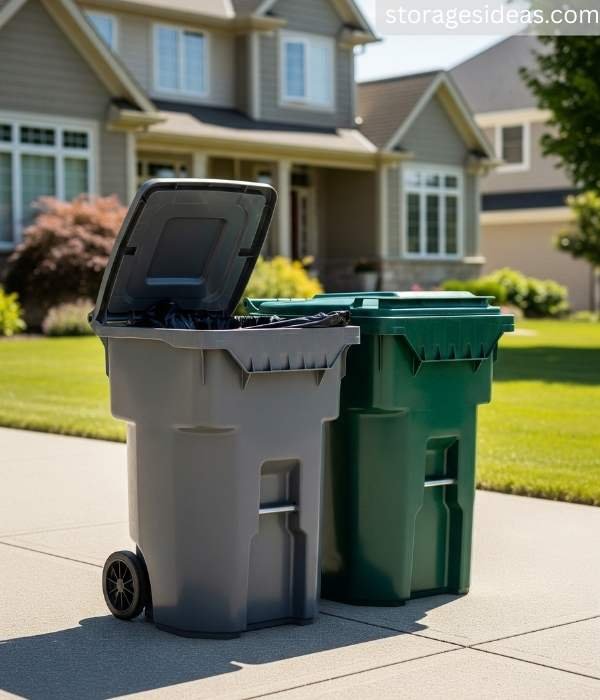
Plastic resin bins, particularly high-density polyethylene (HDPE) or polypropylene, are my first choice for many commercial properties due to their combination of strength, lightweight design, and weather resistance.
Capacity and Grades: These bins range from 30 to 100 gallons. HDPE bins are ideal for heavy-duty usage. They resist cracks and impact damage while remaining relatively lightweight. Some commercial-grade bins include reinforced walls and UV inhibitors to prevent fading and brittleness from sunlight exposure.
Usage Scenarios: Plastic resin bins are perfect for schools, parks, office complexes, and shopping centers. I often place them near building entrances, along pedestrian paths, and at outdoor seating areas where foot traffic is moderate but frequent.
Maintenance: I recommend rinsing bins weekly and using a mild soap solution for stubborn stains. When the sun is strong, I rotate bins or place them in shaded areas to prolong their lifespan. Winter care includes avoiding freezing liquids inside the bins, which can cause cracking.
Common Mistakes: Overloading the bin, placing it in direct sun for prolonged periods, and using low-grade plastic bins in areas with high traffic or potential vandalism.
2. Steel or Galvanized Metal Bins
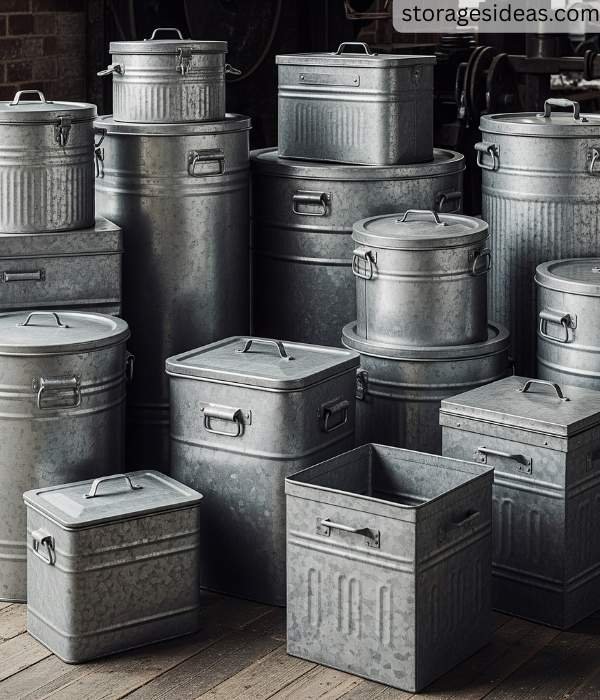
Heavy-duty steel and galvanized metal bins are ideal for high-traffic or industrial areas. I use these bins in urban streets, factories, and warehouse loading zones because they can withstand heavy impacts and resist tampering.
Material and Durability: Galvanized steel is coated to prevent rust and corrosion. The thickness of the steel determines its durability. Industrial-strength bins resist denting and chewing by animals. Fire-safe metal bins also provide added safety in areas with flammable waste.
Usage Scenarios: These bins work well in urban streets, transit hubs, construction sites, and factory yards. I often pair them with secure lids to prevent scavenging by animals or unauthorized access.
Maintenance: Regular inspection is crucial. Check for rust, especially around welds or hinges, and repaint if necessary. Lubricating hinges ensures smooth lid operation, and hosing down the interior prevents odor buildup.
Common Mistakes: Neglecting rust prevention, moving bins incorrectly, causing dents, and placing them in areas where flooding may occur.
3. Recycling-Specific Bins
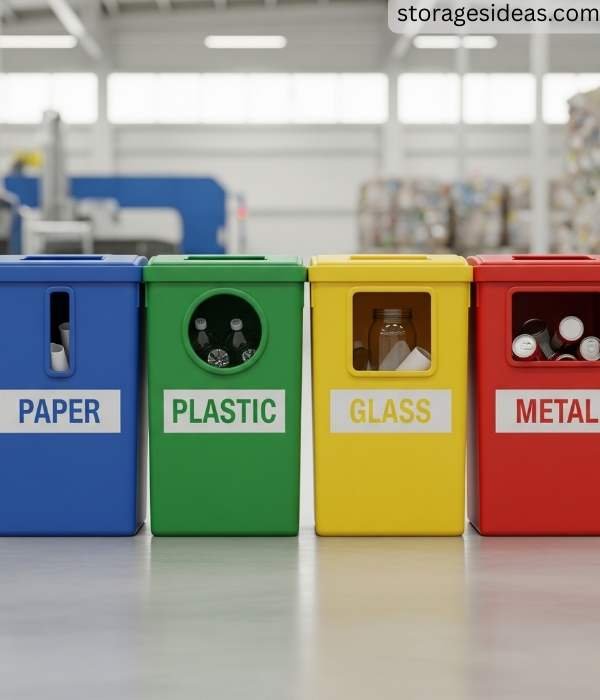
With environmental concerns rising, I recommend recycling-specific bins for offices, malls, schools, and parks. These bins often come with color-coded lids or decals to distinguish between paper, plastic, and glass.
Design and Usage: Internal dividers or separate compartments help maintain clean recycling streams. Bins range from 20 to 60 gallons, which allows them to fit easily in hallways or near outdoor seating areas without occupying too much space.
Placement Tips: Place bins where users can easily identify them, often accompanied by clear signage. I’ve found that positioning them near entrances and high-foot-traffic spots encourages proper use.
Maintenance: Cleaning is essential, especially for wet recyclables. Rinse bins regularly, prevent liquids from stagnating, and ensure signage remains visible and intact.
Common Mistakes: Mixing recyclables with general trash, unclear or faded signage, and insufficient education for staff or users on proper recycling practices.
4. Dual or Multi-Compartment Cans
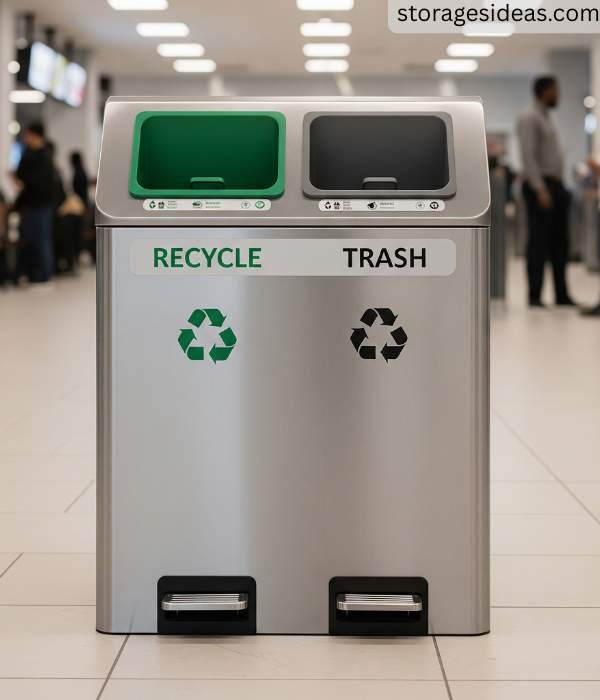
Dual or multi-compartment bins are designed for sorting multiple types of waste at the point of disposal. I use these in cafeterias, large outdoor malls, sports arenas, and university campuses.
Configurations: Common setups include 2-way, 3-way, or even 4-way sorting options for paper, plastics, organics, and general waste. Material choices include heavy-duty plastic, steel, or hybrid combinations.
Usage Scenarios: In food courts, these bins allow patrons to separate organics from recyclables efficiently. In large outdoor campuses, multi-compartment bins reduce contamination and make waste management more systematic.
Maintenance: Each compartment should be cleaned individually. Check labeling for wear and tear and replace if necessary. Regular inspections ensure that dividers remain intact and bins are emptied before overflowing.
Common Mistakes: Confusing users with poor labeling, not emptying compartments on schedule, and using bins with insufficient capacity for high-traffic areas.
5. Open-Top or Dome Lid Bins
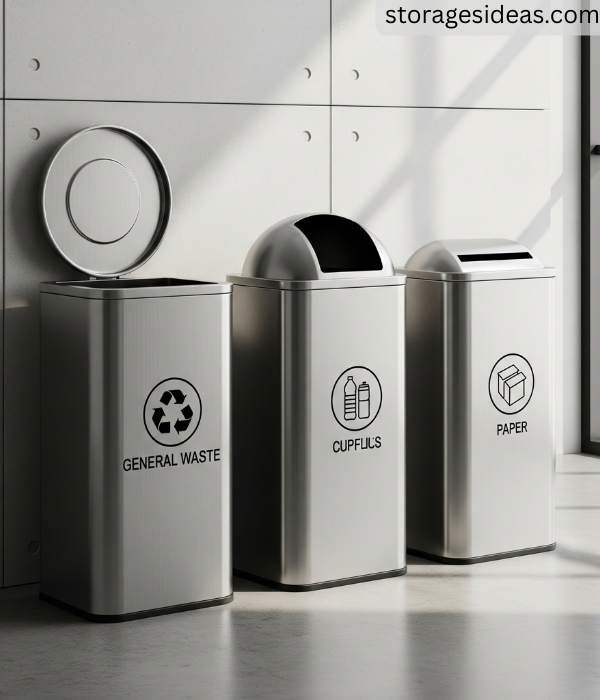
Open-top and dome-lid bins provide quick access for disposal, particularly in outdoor, high-traffic areas. Dome lids help contain odors and keep rainwater from accumulating inside.
Capacity and Placement: Typically, these bins hold 30 to 60 gallons. They are ideal near parks, sports complexes, outdoor malls, and transit stations. I often place weights or attach them to fixed posts in windy areas to prevent tipping.
Maintenance: Regularly clean the dome lids and inspect for cracks or damage. Remove accumulated rainwater and debris to avoid odor and mosquito breeding. Winter protection involves checking for ice buildup that could hinder lid function.
Common Mistakes: Placing bins in open, windy areas without securing them, overfilling during peak usage times, and neglecting to check for water pooling or debris inside the bin.
6. Pedal or Hands-Free Trash Cans

For areas where hygiene is a priority, I use pedal-operated or hands-free bins. They reduce direct contact and prevent the spread of bacteria.
Mechanisms and Design: Pedal bins may be spring-loaded or hydraulic. Sizes range from 10 to 50 gallons, making them suitable for outdoor dining, healthcare facilities, and food courts.
Usage Scenarios: Restaurants, cafes, hospitals, and outdoor kitchens benefit from hands-free disposal, minimizing contamination risks.
Maintenance: Lubricate pedals, inspect springs, and clean inner liners frequently. Check lid alignment and replace worn parts promptly to ensure smooth operation.
Common Mistakes: Overloading the bin, improper placement that hinders pedal access, and failing to perform regular inspections.
7. Underground or Semi-Underground Bins

For high-volume commercial areas, semi-underground bins provide a discreet and efficient solution. Waste is stored below ground level, reducing odors and clutter.
Capacity and Installation: Capacities range from 250 to 1,000 gallons. Installation requires concrete bases and proper drainage systems. Accessibility is critical, with lift systems or removable liners for waste removal.
Usage Scenarios: City centers, shopping malls, large campuses, stadiums, and industrial parks. I’ve used them in high-foot-traffic zones where aesthetics and odor control are critical.
Maintenance: Inspect drainage systems, clean interiors regularly, and check for leaks. Seasonal care includes preventing freezing in winter and ensuring flood-prone areas remain functional.
Common Mistakes: Improper installation, ignoring drainage requirements, overfilling bins, and failing to perform seasonal inspections.
Common Mistakes Businesses Make
From my experience, common pitfalls include:
- Choosing bins that are too small for the traffic volume.
- Ignoring material durability leads to cracked or dented bins.
- Failing to plan for recycling causes contamination.
- Placing bins poorly, obstructing pathways, or creating hazards.
- Overfilling bins damages lids and attracts pests.
- Ignoring seasonal factors like heat, freezing, or flooding.
- Neglecting staff training on bin usage, cleaning, and disposal protocols.
- Skipping regular inspections and maintenance shortens bin lifespan.
How I Maintain Commercial Outdoor Trash Cans
Proper maintenance extends the life of bins and ensures hygiene:
- Weekly Cleaning: Hose down interiors and use mild soap for stubborn debris.
- Odor Control: Sprinkle baking soda or use deodorizing packets.
- Inspect for Damage: Check lids, wheels, and bin walls regularly.
- Seasonal Care: Protect metal bins from rust, prevent freezing in winter, and shade plastic bins in summer.
- Staff Training: Employees should know proper emptying, cleaning, and handling procedures.
- Hands-Free Bins: Lubricate pedals, inspect springs, and check lid alignment.
- Pest Prevention: Secure lids tightly and place bins away from wildlife-prone areas.
- Drainage Checks: Ensure dome and underground bins drain liquids to prevent stagnation.
Tips for Choosing the Right Commercial Outdoor Trash Can
- Assess traffic volume and waste output.
- Consider environmental conditions like wind, rain, and temperature.
- Select materials based on durability needs.
- Choose designs that are accessible and hygienic.
- Factor in aesthetics if bins are visible to customers.
- Ensure easy maintenance and staff-friendly operation.
For additional guidance, check my full guide to decorative outdoor trash cans for comparison and styling ideas.
Final Thoughts
Choosing the right commercial outdoor trash can is crucial for safety, cleanliness, and customer perception. From lightweight plastic bins to heavy-duty steel, dual-compartment bins to semi-underground systems, there’s a solution for every business. With proper placement, maintenance, and attention to common mistakes, your bins can remain functional, hygienic, and professional-looking year-round.
FAQs
Q: How often should commercial outdoor bins be emptied?
A: Daily for high-traffic areas; otherwise, as needed to prevent overflow.
Q: Can I mix recycling and trash in one bin?
A: Not recommended—separate bins improve compliance and reduce contamination.
Q: Are metal bins better than plastic?
A: Metal is fire-resistant and durable; plastic is lightweight and UV-resistant.
Q: How do I control odors?
A: Clean regularly, use deodorizing packets, and ensure lids fit tightly.
Q: Do commercial bins need wheels?
A: Wheels make moving full bins safer and easier

